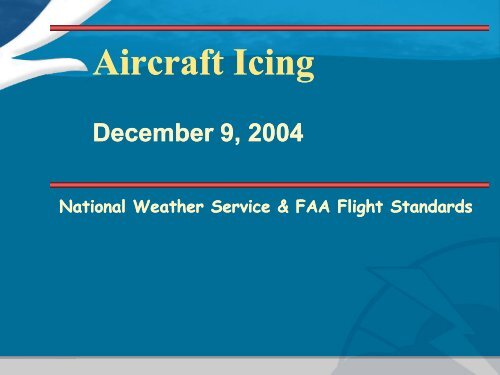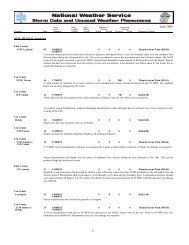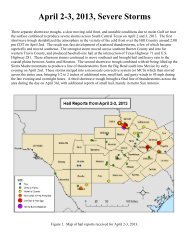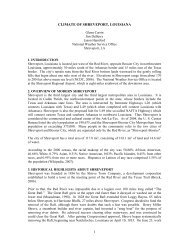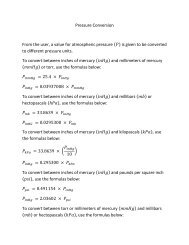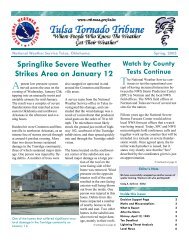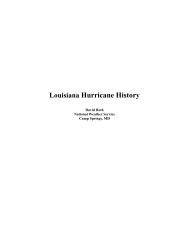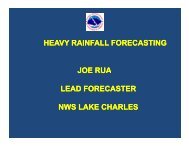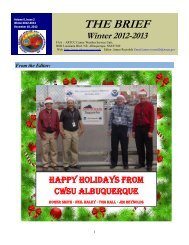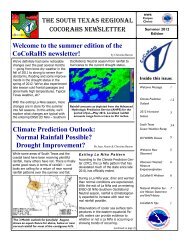Aircraft Icing - National Weather Service Southern Region ...
Aircraft Icing - National Weather Service Southern Region ...
Aircraft Icing - National Weather Service Southern Region ...
Create successful ePaper yourself
Turn your PDF publications into a flip-book with our unique Google optimized e-Paper software.
<strong>Aircraft</strong> <strong>Icing</strong><br />
December 9, 2004<br />
<strong>National</strong> <strong>Weather</strong> <strong>Service</strong> & FAA Flight Standards
ATOMS – <strong>Aircraft</strong> <strong>Icing</strong> – December 2004
We Will Cover<br />
Types Types of icing<br />
A A little on the cause<br />
Some Some effects on flight<br />
<strong>Weather</strong> <strong>Weather</strong> map clues<br />
Sources Sources for icing forecasts<br />
ATOMS – <strong>Aircraft</strong> <strong>Icing</strong> – December 2004
Ice is Bad!<br />
“When ice is encountered, immediately<br />
start working to get out of it.<br />
Unless the condition is freezing rain, or<br />
freezing drizzle it rarely requires fast<br />
action and certainly never panic action,<br />
but it does call for positive action.”<br />
Capt. Robert Buck<br />
ATOMS – <strong>Aircraft</strong> <strong>Icing</strong> – December 2004
Fact:<br />
Ice can form on the surface of an aircraft at 0 o C<br />
(32 o F) or colder when liquid water is present.<br />
ATOMS – <strong>Aircraft</strong> <strong>Icing</strong> – December 2004
Quick (trick?) Question<br />
You are descending into an airport where the<br />
air temperature is 33 o F. There is little or no<br />
risk of structural icing on your plane!<br />
True?<br />
False?<br />
Temperature of the aircraft determines the degree of<br />
ice threat when air temperatures are close to freezing.<br />
ATOMS – <strong>Aircraft</strong> <strong>Icing</strong> – December 2004
Quick (trick?) Question<br />
It will be safe to fly through an area of icing if<br />
your plane is equipped with deicing equipment.<br />
True?<br />
False?<br />
NASA found nearly 50% of the total drag from ice remained<br />
after the protected surfaces had been cleared!<br />
ATOMS – <strong>Aircraft</strong> <strong>Icing</strong> – December 2004
Quick (trick?) Question<br />
What is the freezing point<br />
(temperature) of water?<br />
It depends!<br />
ATOMS – <strong>Aircraft</strong> <strong>Icing</strong> – December 2004
Fact:<br />
Nearly ALL icing happens in clouds that<br />
contain ‘super cooled’ water droplets.<br />
Super cooled means water that is colder than 32 o F.<br />
Most clouds contain supercooled water drops.<br />
Drops strike the leading edge of an airfoil<br />
Freeze on impact<br />
Worst icing occurs with big super cooled<br />
water droplets<br />
ATOMS – <strong>Aircraft</strong> <strong>Icing</strong> – December 2004
<strong>Icing</strong> Forms Most Readily:<br />
On the Leading Edge of the airfoil<br />
Where the Radius of Curvature is Shortest<br />
ATOMS – <strong>Aircraft</strong> <strong>Icing</strong> – December 2004
Ice forms first on the<br />
“Shortest Shortest Radius of Curvature Curvature”<br />
ATOMS – <strong>Aircraft</strong> <strong>Icing</strong> – December 2004
Ice forms first on the<br />
“Shortest Shortest Radius of Curvature Curvature”<br />
ATOMS – <strong>Aircraft</strong> <strong>Icing</strong> – December 2004
Ice forms first on the<br />
“Shortest Shortest Radius of Curvature Curvature”<br />
ATOMS – <strong>Aircraft</strong> <strong>Icing</strong> – December 2004
Ice forms first on the<br />
“Shortest Shortest Radius of Curvature Curvature”<br />
ATOMS – <strong>Aircraft</strong> <strong>Icing</strong> – December 2004
Definition<br />
Four classes of intensity<br />
• Trace<br />
– Barely preceptible<br />
– Not hazardous unless encountered for more than an hour<br />
•Light<br />
– Prolonged exposure may create a flight problem<br />
– Occasional use of deicing is effective<br />
•Moderate<br />
– Even short encounters a potential hazard<br />
– Use of deicing or diversion is required<br />
•Severe<br />
– Even immediate deicing is ineffective<br />
– Immediate diversion is necessary<br />
ATOMS – <strong>Aircraft</strong> <strong>Icing</strong> – December 2004
• Clear<br />
Definitions<br />
ATOMS – <strong>Aircraft</strong> <strong>Icing</strong> – December 2004<br />
Three kinds of icing<br />
– Glossy, clear, or translucent<br />
– Formed by slow freezing of supercooler water<br />
– Cumulus clouds<br />
•Rime<br />
– Rough, milky, opaque – think of home freezer<br />
– Formed by rapid freezing of small supercooled<br />
water<br />
– Stratus clouds<br />
•Mixed<br />
– Dual characteristics
Clear <strong>Icing</strong> – Big Drops<br />
ATOMS – <strong>Aircraft</strong> <strong>Icing</strong> – December 2004
Rime <strong>Icing</strong> – Small Drops<br />
ATOMS – <strong>Aircraft</strong> <strong>Icing</strong> – December 2004
Fact:<br />
The kind of cloud plays a big role in icing.<br />
Cumulus clouds<br />
Bigger drops<br />
High water content<br />
More supercooled water<br />
Stratus clouds<br />
Smaller drops<br />
Less water content<br />
Less supercooled water<br />
ATOMS – <strong>Aircraft</strong> <strong>Icing</strong> – December 2004
<strong>Icing</strong> vs. Cloud Type: Stratus<br />
Small Cloud Droplets<br />
Rime/Mixed most common<br />
Usually in a layer 3,000’-4,000’ thick<br />
Weak updrafts<br />
Mostly in upper part of cloud<br />
Wide horizontal extent<br />
ATOMS – <strong>Aircraft</strong> <strong>Icing</strong> – December 2004
More Ice, Less Water = Good<br />
ATOMS – <strong>Aircraft</strong> <strong>Icing</strong> – December 2004<br />
Stratus Cloud
<strong>Icing</strong> vs. Cloud Type: Cumulus<br />
Large cloud droplets<br />
<strong>Icing</strong> near top of cloud updraft<br />
Heavy rime most frequently in cloud tops<br />
Rime often found in mature thunderstorms<br />
Clear icing most likely in growing cloud<br />
Small horizontal extent<br />
ATOMS – <strong>Aircraft</strong> <strong>Icing</strong> – December 2004
Big Drops Water = Bad<br />
ATOMS – <strong>Aircraft</strong> <strong>Icing</strong> – December 2004<br />
Cumulus Cloud
•Major cause of<br />
•<strong>Aircraft</strong> <strong>Icing</strong><br />
Sustained Updraft<br />
•Key Source of<br />
•Super-Cooled<br />
•Large Drops (SLD)<br />
ATOMS – <strong>Aircraft</strong> <strong>Icing</strong> – December 2004
Fact:<br />
Snow Snow<br />
ATOMS – <strong>Aircraft</strong> <strong>Icing</strong> – December 2004
Fact: Sleet<br />
ATOMS – <strong>Aircraft</strong> <strong>Icing</strong> – December 2004
ATOMS – <strong>Aircraft</strong> <strong>Icing</strong> – December 2004<br />
Fact: Freezing Freezing Rain
Strategy<br />
Preflight planning<br />
ATOMS – <strong>Aircraft</strong> <strong>Icing</strong> – December 2004<br />
Where are areas of active weather?<br />
Where are the fronts?<br />
Where are they moving?<br />
What are cloud tops?<br />
What kind of cloud<br />
Cumulus?<br />
Stratus?<br />
How high are cloud bases?
Strategy<br />
Preflight planning<br />
What is the freezing level?<br />
How does that compare with cloud tops?<br />
Are there warm layers above? Below?<br />
Are there AIRMETs or SIGMETs out?<br />
Will you fly across or near an active front?<br />
Are there areas of precipitation?<br />
Along or near planned route?<br />
Moving toward or across route?<br />
ATOMS – <strong>Aircraft</strong> <strong>Icing</strong> – December 2004
Strategy<br />
Best strategy is AVOID ice<br />
Even if aircraft is certified / equipped don’t<br />
purposely fly into an area of known icing<br />
Get a good preflight weather briefing<br />
Inspect flight surfaces carefully<br />
Clean ice / snow from plane<br />
Keep in touch with ATC<br />
Listen to PIREPs<br />
File PIREPs<br />
ATOMS – <strong>Aircraft</strong> <strong>Icing</strong> – December 2004
Effects of <strong>Icing</strong> Are<br />
“Cumulative<br />
“Cumulative”<br />
Decreases Lift<br />
Decreases Thrust<br />
Increases Weight<br />
Increases Drag<br />
ATOMS – <strong>Aircraft</strong> <strong>Icing</strong> – December 2004
<strong>Icing</strong> Effects Accumulate<br />
ATOMS – <strong>Aircraft</strong> <strong>Icing</strong> – December 2004
<strong>Icing</strong> Effects Accumulate<br />
ATOMS – <strong>Aircraft</strong> <strong>Icing</strong> – December 2004
<strong>Icing</strong> Effects Accumulate<br />
ATOMS – <strong>Aircraft</strong> <strong>Icing</strong> – December 2004
<strong>Icing</strong> Effects Accumulate<br />
ATOMS – <strong>Aircraft</strong> <strong>Icing</strong> – December 2004
<strong>Icing</strong> Effects Accumulate<br />
ATOMS – <strong>Aircraft</strong> <strong>Icing</strong> – December 2004<br />
Result is all bad!
Rules of Thumb<br />
There is no rule of thumb that always works<br />
Heaviest icing is most often reported 4,000 -<br />
6,000 ft above the freezing level.<br />
ATOMS – <strong>Aircraft</strong> <strong>Icing</strong> – December 2004
Sources of Ice in Clouds<br />
• Supercooled Large Drops (SLD) –<br />
•By far the most dangerous<br />
• Typically found in freezing rain or drizzle<br />
• Drop sizes - 30-300 microns<br />
• Precipitation/cloud -<br />
• The most common form of icing<br />
• 10 to 50 microns in diameter<br />
ATOMS – <strong>Aircraft</strong> <strong>Icing</strong> – December 2004
ATOMS – <strong>Aircraft</strong> <strong>Icing</strong> – December 2004
ATOMS – <strong>Aircraft</strong> <strong>Icing</strong> – December 2004
ATOMS – <strong>Aircraft</strong> <strong>Icing</strong> – December 2004
ATOMS – <strong>Aircraft</strong> <strong>Icing</strong> – December 2004
ATOMS – <strong>Aircraft</strong> <strong>Icing</strong> – December 2004
ATOMS – <strong>Aircraft</strong> <strong>Icing</strong> – December 2004
ATOMS – <strong>Aircraft</strong> <strong>Icing</strong> – December 2004
Where is <strong>Icing</strong> Worst?<br />
• Near the tops of clouds (larger drops)<br />
• In freezing precipitation (SLD) -<br />
usually below 100<br />
Mainly when not expected!!<br />
ATOMS – <strong>Aircraft</strong> <strong>Icing</strong> – December 2004
33 33o F to –4o F<br />
Warmer – No Ice<br />
ATOMS – <strong>Aircraft</strong> <strong>Icing</strong> – December 2004<br />
<strong>Icing</strong> Temperatures<br />
Colder – water droplets<br />
become ice crystals
ATOMS – <strong>Aircraft</strong> <strong>Icing</strong> – December 2004<br />
<strong>Icing</strong> Temperatures<br />
But But…(isn’t …(isn’t there always a catch?)<br />
Sometimes even colder than -25<br />
Especially in thunderstorms<br />
because drops are big and the<br />
updrafts so strong<br />
25 o<br />
o C
Thunderstorm – Severe <strong>Icing</strong><br />
20 miles!!<br />
ATOMS – <strong>Aircraft</strong> <strong>Icing</strong> – December 2004
ATOMS – <strong>Aircraft</strong> <strong>Icing</strong> – December 2004<br />
ATR <strong>Icing</strong> Accident<br />
On October 31, 1994, ATR-72 crashed near<br />
Roselawn, Indiana, killing 64 passengers and 4<br />
crew.<br />
NTSB tied the aircraft's loss of control to a unexpected<br />
movement of an aileron after a ridge of ice formed behind the<br />
deice boots.<br />
The plane went into an uncommanded roll that resulted in a<br />
rapid decent. The aircraft had been in a holding pattern with<br />
autopilot engaged.<br />
Result of SLD!!
ATOMS – <strong>Aircraft</strong> <strong>Icing</strong> – December 2004<br />
<strong>Weather</strong> Map Clues<br />
Or, where you might find likely areas of<br />
ice by just looking at the weather maps<br />
Some Terms:<br />
1. Frontal Systems<br />
2. Overrunning<br />
3. Lake Effect<br />
4. Wrap Around
ATOMS – <strong>Aircraft</strong> <strong>Icing</strong> – December 2004
ATOMS – <strong>Aircraft</strong> <strong>Icing</strong> – December 2004
ATOMS – <strong>Aircraft</strong> <strong>Icing</strong> – December 2004
ATOMS – <strong>Aircraft</strong> <strong>Icing</strong> – December 2004
ATOMS – <strong>Aircraft</strong> <strong>Icing</strong> – December 2004<br />
Frontal Systems<br />
Large areal coverage<br />
Big variation in condition both<br />
East-west<br />
North-south<br />
Conditions change quickly
Frontal System<br />
ATOMS – <strong>Aircraft</strong> <strong>Icing</strong> – December 2004
Quick (trick?) Question<br />
When flying near a frontal system, flying the<br />
shortest route through the front is best to avoid<br />
prolonged exposure to icing conditions.<br />
True?<br />
False?<br />
ATOMS – <strong>Aircraft</strong> <strong>Icing</strong> – December 2004
Pick a Safe Route<br />
ATOMS – <strong>Aircraft</strong> <strong>Icing</strong> – December 2004
<strong>Weather</strong> Map Clues<br />
OVER-RUNNING<br />
Very common in the southern states in winter...<br />
Another good way to find ice!<br />
Large coverage area<br />
Little east-west variance<br />
Gradual north-south variance<br />
Mainly stratiform precipitation<br />
Some embedded thunderstorms possible<br />
ATOMS – <strong>Aircraft</strong> <strong>Icing</strong> – December 2004
Overruning<br />
ATOMS – <strong>Aircraft</strong> <strong>Icing</strong> – December 2004
Lake Effect<br />
Downwind of large lakes<br />
In winter<br />
Small area affected<br />
Confined to 50-100 miles from source<br />
Low cloud tops<br />
Occasionally embedded thunderstorms<br />
Occasional SLD<br />
ATOMS – <strong>Aircraft</strong> <strong>Icing</strong> – December 2004
Lake Effect<br />
ATOMS – <strong>Aircraft</strong> <strong>Icing</strong> – December 2004
Wrap Around Effect<br />
•Found on the west side of large lows<br />
•Large area affected<br />
•Low cloud tops<br />
•Falling freezing levels<br />
•Isolated SLD<br />
ATOMS – <strong>Aircraft</strong> <strong>Icing</strong> – December 2004
Wrap Around Clouds<br />
ATOMS – <strong>Aircraft</strong> <strong>Icing</strong> – December 2004
Information Sources<br />
1) Flight <strong>Service</strong> Stations 1-800-WX BRIEF<br />
2) ADDS Site http://adds.aviationweather.gov<br />
Current <strong>Icing</strong> Potential & Forecast <strong>Icing</strong> Potential<br />
Charts (CIP/FIP)<br />
3) DUATS<br />
ATOMS – <strong>Aircraft</strong> <strong>Icing</strong> – December 2004
More Information Sources<br />
1. PIREPs - get em, give em<br />
2. Electronic <strong>Icing</strong> Handbook (training!!! Free!!)<br />
http://www.aar400.tc.faa.gov/programs/FlightSafety/icing/eaihbk.htm<br />
ATOMS – <strong>Aircraft</strong> <strong>Icing</strong> – December 2004
<strong>Icing</strong> Forecasts (Experimental)<br />
ATOMS – <strong>Aircraft</strong> <strong>Icing</strong> – December 2004<br />
CIP – Current <strong>Icing</strong> Potential<br />
Current <strong>Icing</strong> Potential – 16Z FL090<br />
Automatically<br />
generated<br />
Probability of icing<br />
in percentage<br />
SLD
ATOMS – <strong>Aircraft</strong> <strong>Icing</strong> – December 2004<br />
Official <strong>Icing</strong> Forecasts:<br />
AIRMETS - ZULU<br />
Miami AIRMET Zulu<br />
<strong>Icing</strong> and Freezing Levels<br />
MIAZ WA 121445 AIRMET ZULU UPDT 2 FOR ICE AND FRZLVL<br />
VALID UNTIL 122100 . AIRMET ICE...NC SC GA FL AND CSTL<br />
WTRS FROM 170E ORF TO 140SSE ILM TO CRG TO 50SW<br />
ABY TO GQO TO HMV TO 170E ORF OCNL MOD RIME/MXD<br />
ICGICIP BTN 140 AND FL270. CONDS CONTG BYD 21Z THRU<br />
03Z. . FRZLVL...100-120 NW OF MGM-ORF LN SLPG TO 140-<br />
160 S OF 180SSW CEW-140SSE ILM LN.
ATOMS – <strong>Aircraft</strong> <strong>Icing</strong> – December 2004<br />
Other Sources<br />
TAF<br />
TAF KMEM 121130Z 061212 36014KT 3SM –FZDZ BR OVC020<br />
Winds and Temps Aloft<br />
3000 6000 9000 12000 18000…… 39000<br />
LBB 3409+03 3410-03 3314-10 3475-12 3387-24
ATOMS – <strong>Aircraft</strong> <strong>Icing</strong> – December 2004<br />
Other Sources<br />
<strong>National</strong> Convective<br />
<strong>Weather</strong> Forecast<br />
NCWF
ATOMS – <strong>Aircraft</strong> <strong>Icing</strong> – December 2004<br />
Other Sources<br />
PIREP<br />
JFK UA /OV JFK180005/TM 1649/FL250/TP LR25/IC MOD RIME=<br />
Use PIREPS thoughtfully<br />
1. Not all ice is reported…<br />
2. Ice can appear and disappear rapidly<br />
3. What kind of aircraft reported the ice?<br />
(A fast jet may encounter no ice while you run into light<br />
icing in Cessna 172.<br />
Why? Friction!)
We Covered<br />
Types Types of icing<br />
A A bit on the cause<br />
Some Some effects on flight<br />
<strong>Weather</strong> <strong>Weather</strong> map clues<br />
Sources Sources for icing forecasts<br />
ATOMS – <strong>Aircraft</strong> <strong>Icing</strong> – December 2004
Questions or Comments?<br />
ATOMS – <strong>Aircraft</strong> <strong>Icing</strong> – December 2004


